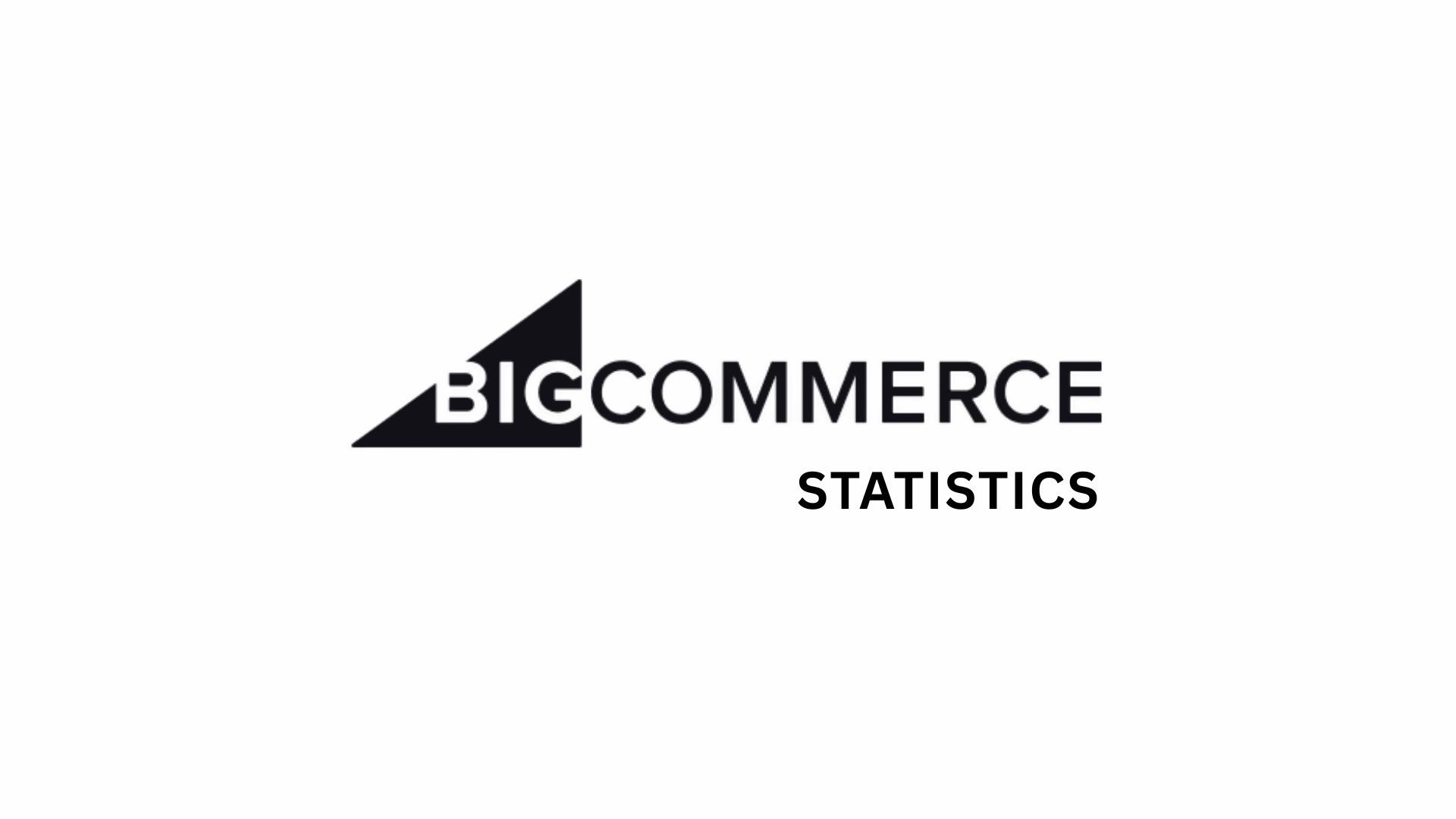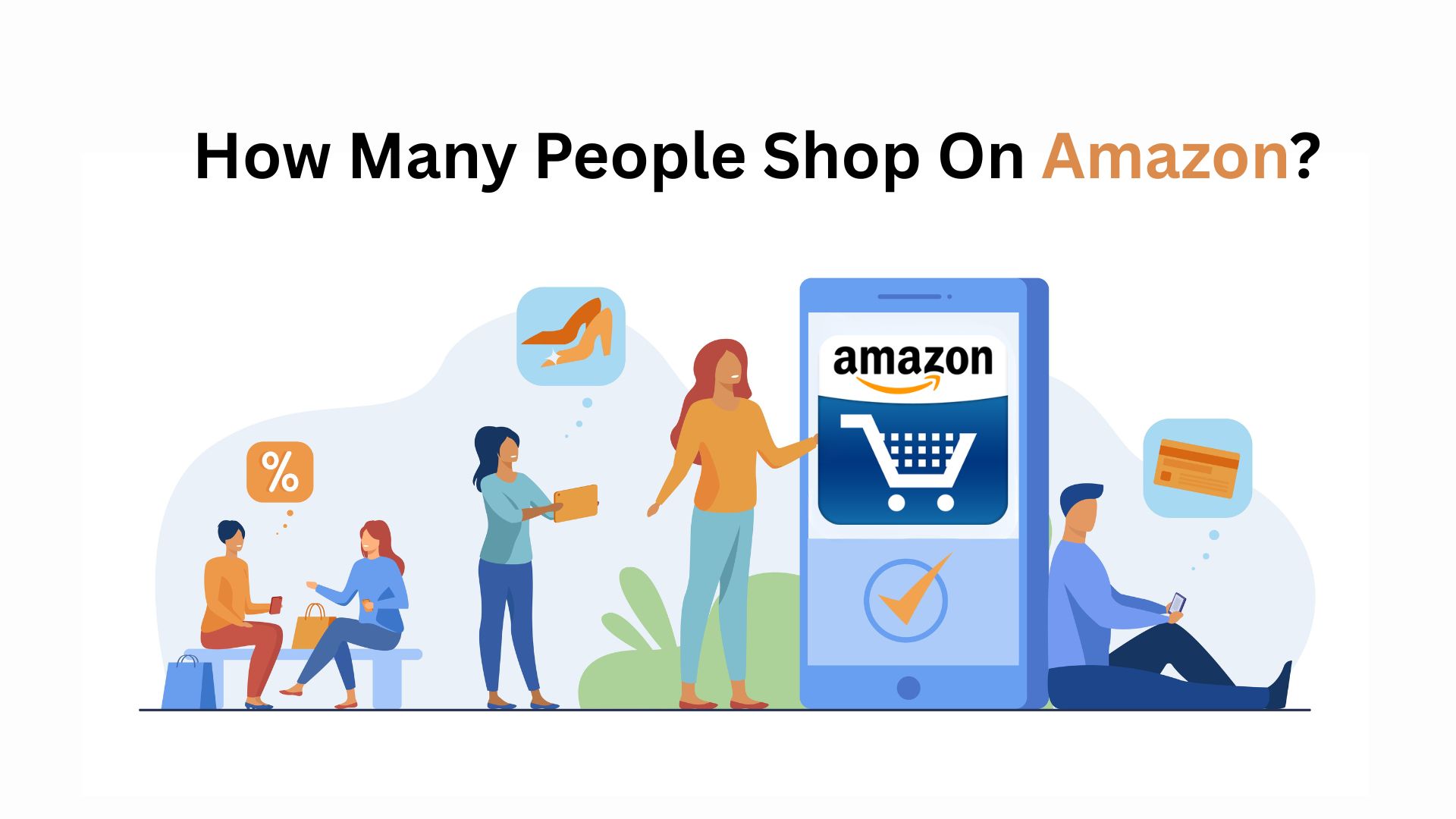Shopify vs WooCommerce Statistics By Market Share and Security (2025)
Updated · Jun 23, 2025

Table of Contents
Introduction
Shopify vs WooCommerce Statistics: In the fast-evolving world of eCommerce, there are two platforms that continue to dominate the discussion: Shopify and WooCommerce. The choice between these two platforms can be life-shaping for a budding entrepreneur or an experienced online merchant. Both platforms grew significantly throughout 2024, seeing several major changes in market share, revenue, and user preference.
This article shares the latest Shopify vs WooCommerce statistics, comparisons, and insights so that one can understand how Shopify and WooCommerce rank against each other in terms of performance, popularity, cost, features, and so on.
Editor’s Choice
- Shopify revenue for 2024 rose to US$8.8 billion, a jump of 22.3% from 2023.
- WooCommerce has more than 6,000 extensions, many of which are free.
- Shopify users pay around US$84 each month, and WooCommerce sites charge between US$30 and US$60 monthly.
- Shopify App Store has 8,000+ apps, and WooCommerce Plugin Directory lists 60,000+ plugins.
- Due to WooCommerce’s integration with WordPress and flexibility, it has the highest market share of 38.74% compared to 10.32% by Shopify.
- With WooCommerce providing more flexibility, it currently manages to outscore Shopify with an estimated total store count exceeding 4.64 million by Q2 2025.
- While Shopify dominates in the United States (2.85 million stores), Canada (194,553), and Australia (42,921), WooCommerce leads in India (135,274), Italy (112,726), and the Netherlands (107,891).
- In industry usage, Shopify leads Lifestyle with 7.13%, while WooCommerce has a far broader distribution over niche industries, accounting for 92.24% use in the Others category.
- Shopify uses fixed pricing under subscription models ranging from US$39 to US$399 per month, averaging about US$84 per month, while WooCommerce’s average monthly fees are much lower (US$30 to US$60).
- Shopify offers additional protection with PCI DSS-compliant security, SSL, machine learning fraud detection, and monitoring around the clock; WooCommerce must rely on third-party tools, 90% of its stores use SSL, and 60% apply firewalls.
- Shopify entered into a collaboration with Chargeflow to completely automate chargeback resolution, estimating that chargebacks eat up 0.47% of merchant revenue, with a refund of US$15 fees when disputes are won; WooCommerce users have to rely on third-party payment processors for such assistance.
- Shopify has blocked fraudulent bookings that could have cost merchants more than US$13 billion in GMV, whereas merchants using Shopify Payments enjoy a 99.9% approval rate.
- Around 65% of the WooCommerce stores run regular antivirus and malware scans for potential threats.

(Reference: colorwhistle.com)
- The data exhibits the share of the respective popular eCommerce platforms and themes in a given context, possibly among those websites using WordPress or in a targeted sample of online stores.
- WooCommerce defends 38.74% market share, thus making it the biggest among eCommerce websites in this selection. This portrays the strong popularity of WooCommerce, possibly due to flexibility, integration with WordPress, and an abundant plugin ecosystem. Woo Themes (themes crafted specifically for WooCommerce by the native creators) hold 14.95% of the share, indicating that a good number of WooCommerce users do go for native themes for optimum performance and compatibility.
- Squarespace Online comes in at 14.67%, making it closely placed to Woo Themes in usage. Squarespace gives a hosted, design-centred eCommerce experience, and this number proves its allure for the users who rate ease of use and aesthetic control high on their list.
- Shopify has 10.32%, proving this to be quite a huge portion, but smaller than that of WooCommerce and Squarespace.
- Though one of the top platforms in the world, it might be underrepresented here as WordPress-based solutions dominate in this context.
- WixStores total 8.09%, showing steady adoption among small businesses and individuals who appreciate its drag-and-drop simplicity and low barrier of entry.
- Other platforms make up the remaining 13.22%, indicating the existence of a long tail comprising niche or regional eCommerce tools that, when combined, still hold a significant market share.
- Hence, WooCommerce with associated themes reigns over this landscape, while Squarespace, Shopify, and Wix gather further, albeit smaller yet significant, user bases.
Active Stores
Shopify Active Stores By Category

(Reference: statista.com)
WooCommerce
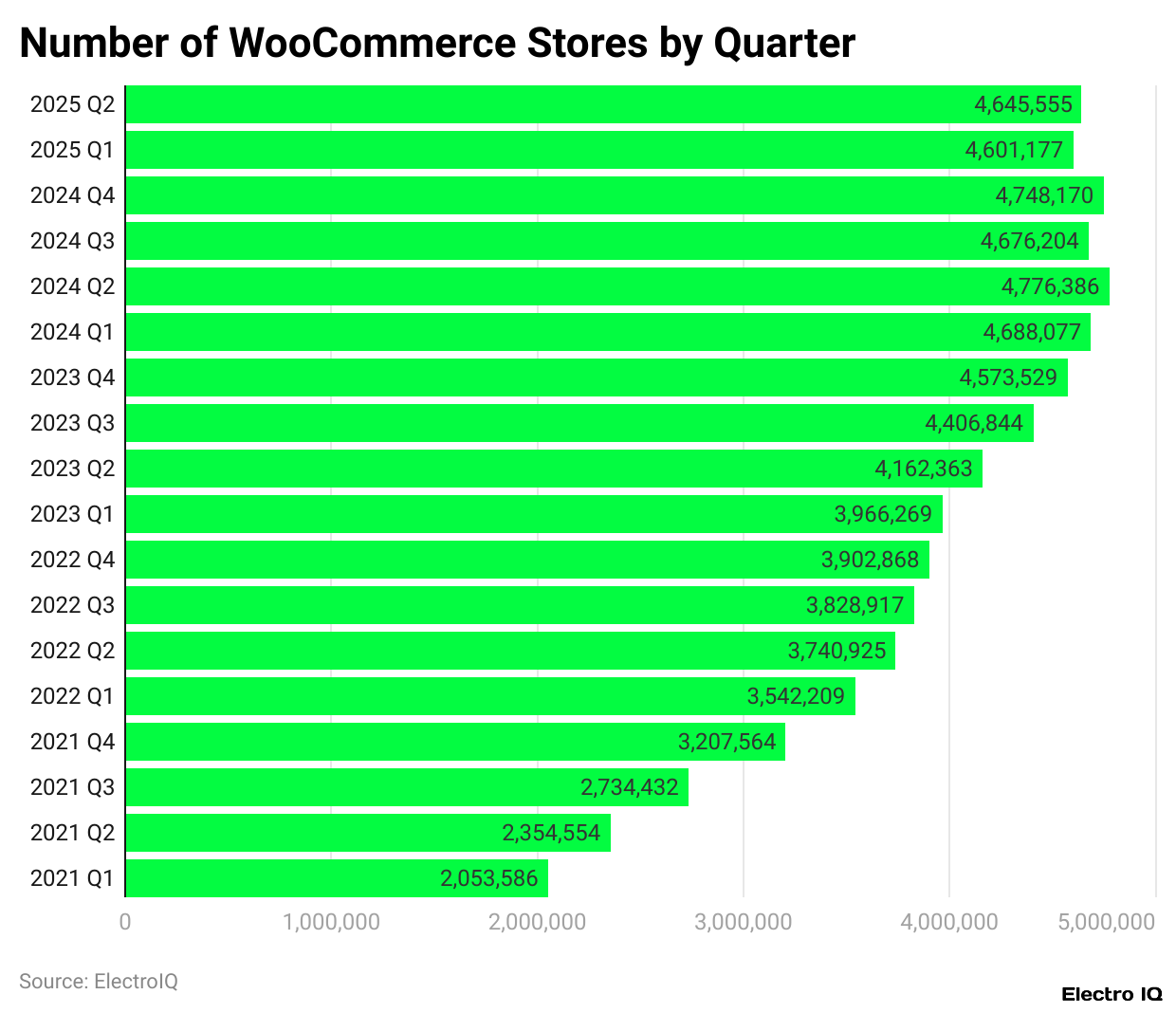
(Reference: shoptrial.co)
- According to Statista and Shoptrial, Shopify vs WooCommerce statistics state that home and garden now stands as the second most-visited category, exhibiting a catalogue comprising some 107,000 stores offering furniture, décor, and household essentials.
- With more buyers embracing online mode for purchasing home improvement and lifestyle merchandise, the Home and Garden category is witnessing an exciting shift.
- Beauty and Fitness lies close behind with almost 102,000 stores in various niches of cosmetics, skin care, and wellness products. These figures put forth the assertion that fashion, home essentials, and personal care stand tall as the front runners for eCommerce success on Shopify, resting on high consumer demand and repeat purchases.
- From the WooCommerce side, the number of active stores is ever-fluctuating but remains persistently high.
- The market saw some 4,645,555 active WooCommerce stores in Q2 2025, rising only modestly by some 0.96% when compared with the previous quarter.
- On the other hand, from Q1 2025, there was a very slight fall of 0.80%, lowering the figure from the 4,748,170 registered in Q4 2024.
- Something worth mentioning is that Q4 2024 growth stood at 1.5%- although the original document probably had a typo, putting the percentage sign together with the number with no space.
- Variances show in the quarterly growth rates as examined through historical data. It decreased by 2.10% in Q3 2024, whereas Q2 2024 experienced a growth of 1.88%.
- WooCommerce enjoyed 2.53% growth in Q1 2024 and 3.77% growth in Q4 2023. The largest growth was in Q3 2023 with a yield of 5.84%, trailed by Q2 2023 at 4.94% and Q1 2023 at 3.38%.
Active Stores By Country
Shopify
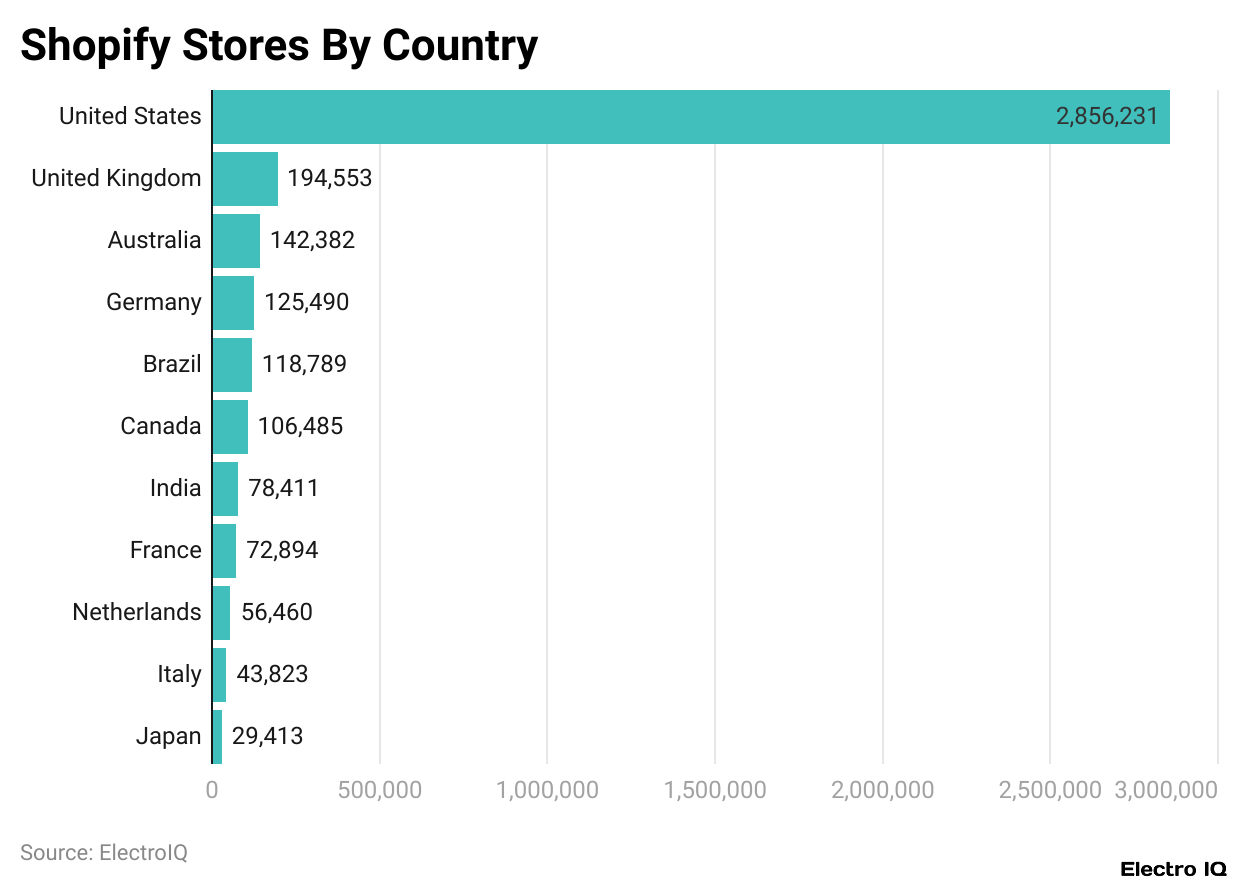
(Reference: demandsage.com)
WooCommerce
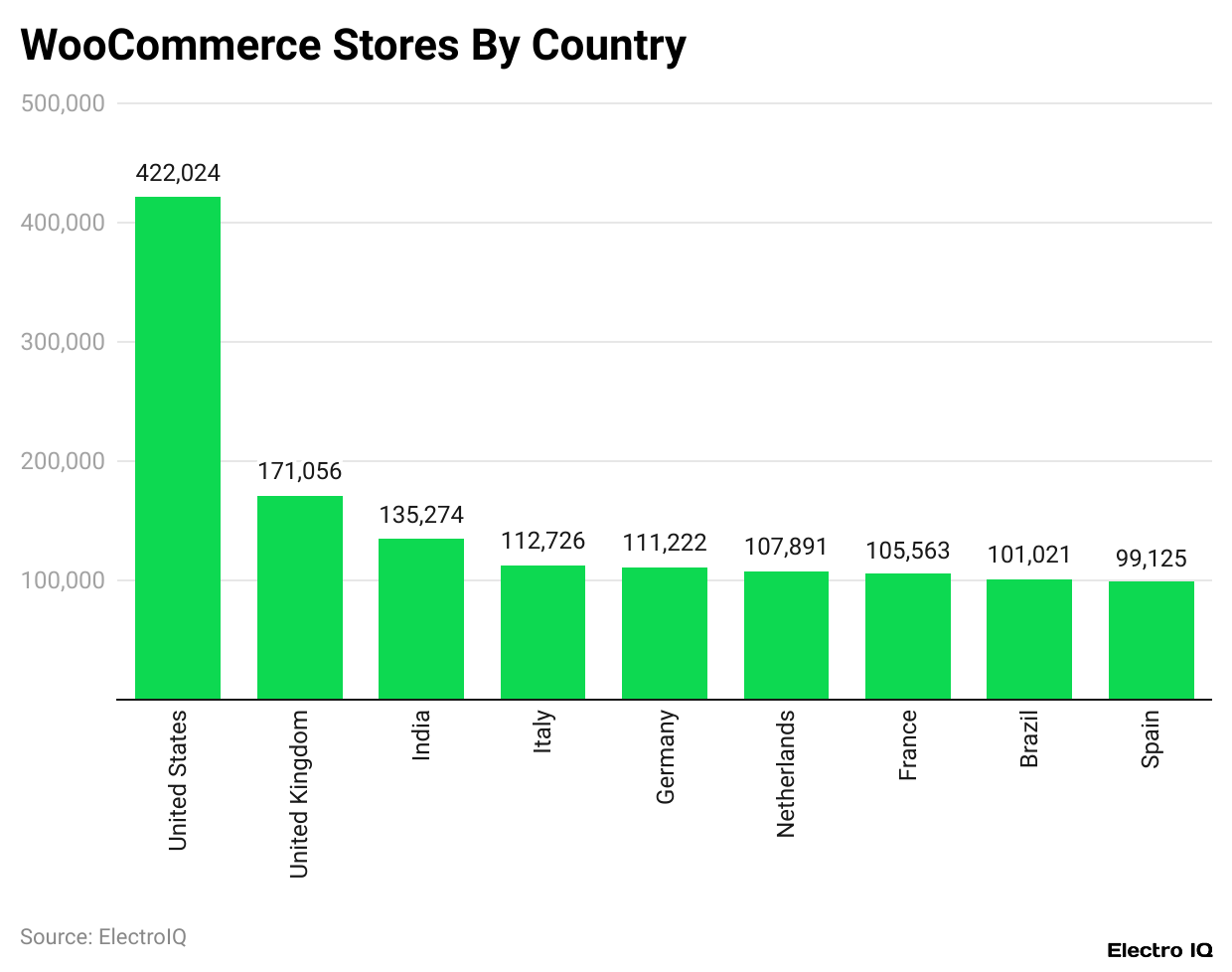
(Reference: shoptrial.co)
- According to Demandsage and Shoptrial, Shopify vs WooCommerce statistics show that the United States has the highest number of active stores for either platform, with a top count of 2,856,231 as opposed to just 422,024 for WooCommerce.
- In the United Kingdom, Shopify beats 194,553 stores and WooCommerce 171,056; strong competition indeed. India reverses the case, where WooCommerce leads with 135,274 stores against 78,411 for Shopify, suggesting that in cost-sensitive markets, there is a place for open source.
- Italy again prefers WooCommerce with 112,726 stores over 43,823 for Shopify.
- Germany, meanwhile, has 125,490 Shopify stores and offers WooCommerce a very close second with 111,222.
- The Netherlands appears to follow the trend, with WooCommerce just a small lead at 107,891 versus 56,460 for Shopify.
- A near-balanced preference for tools is found in France, with WooCommerce having 105,563 stores and Shopify with 72,894 stores.
- In contrast, another important market of Latin America tends to favour Shopify, with 118,789 stores versus 101,021 stores that opt for WooCommerce.
- Last, Spain does not make it among the main countries of Shopify and, unlike, reports 99,125 WooCommerce stores, which emphasise the position held by WooCommerce through Southern Europe.
Industry Usage
Shopify
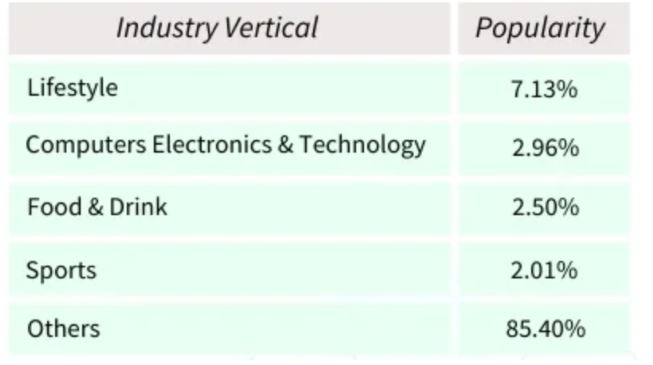
WooCommerce

(Source: colorwhistle.com)
- As per Colorwhistle, Shopify vs WooCommerce statistics reveal that Shopify is popular in the Lifestyle category, where it commands a share of 7.13%; this is far greater than WooCommerce’s share of 1.62% in the same Vertical.
- In the Computers, Electronics & Technology category, Shopify slightly led with 2.96% against WooCommerce’s 2.81%.
- In Food & Drink, Shopify again leads with 2.50%, with WooCommerce a close second at 1.65%.
- In Sports, Shopify stands at 2.01%, while this category is not highly listed for WooCommerce, suggesting exposures to the latter are probably negligible.
- The docket appears to block WooCommerce on the “Others” category with the massive 92.24% while Shopify stands at 85.40%, showing that WooCommerce is more diversified, with more dispersed usage across smaller or niche targets.
Website Usage Across The Globe
Shopify
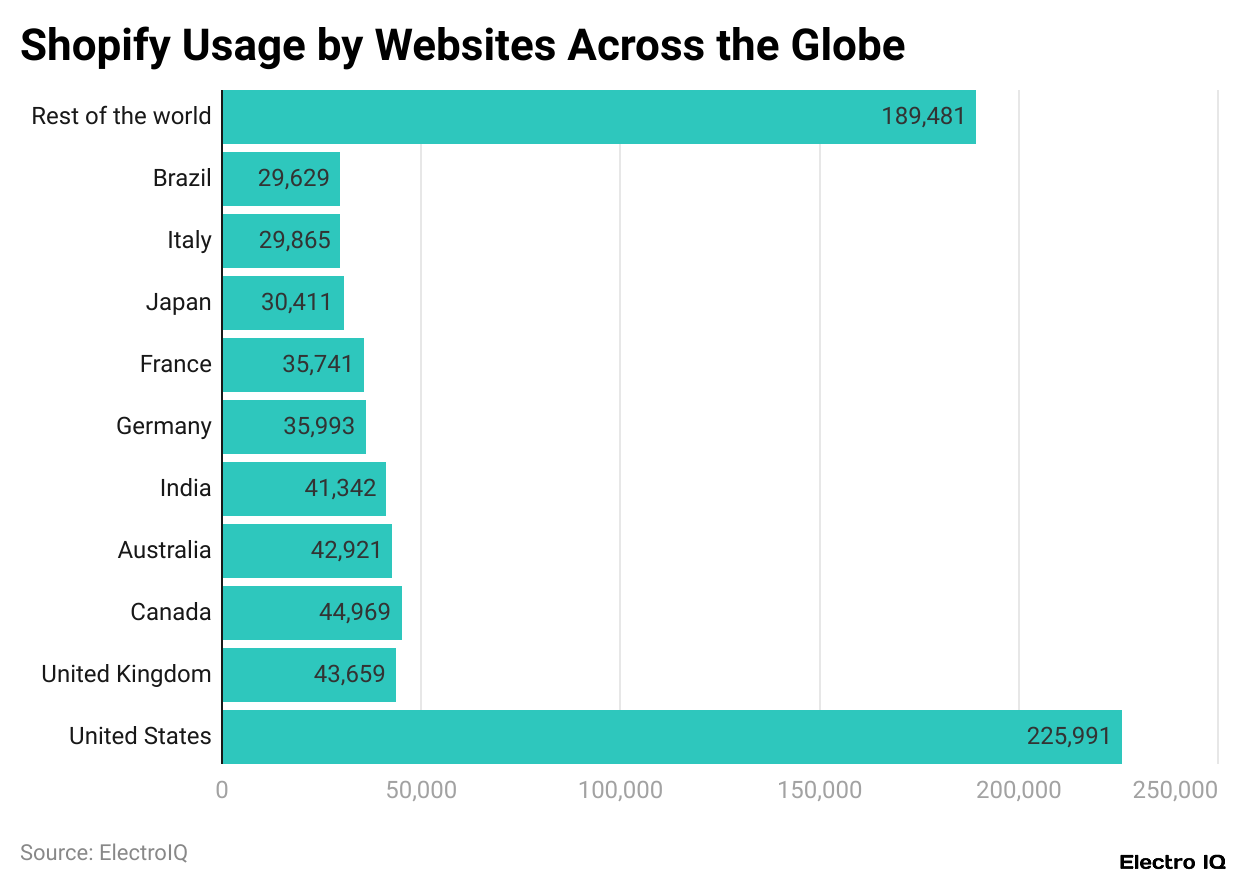
(Reference: colorwhistle.com)
WooCommerce
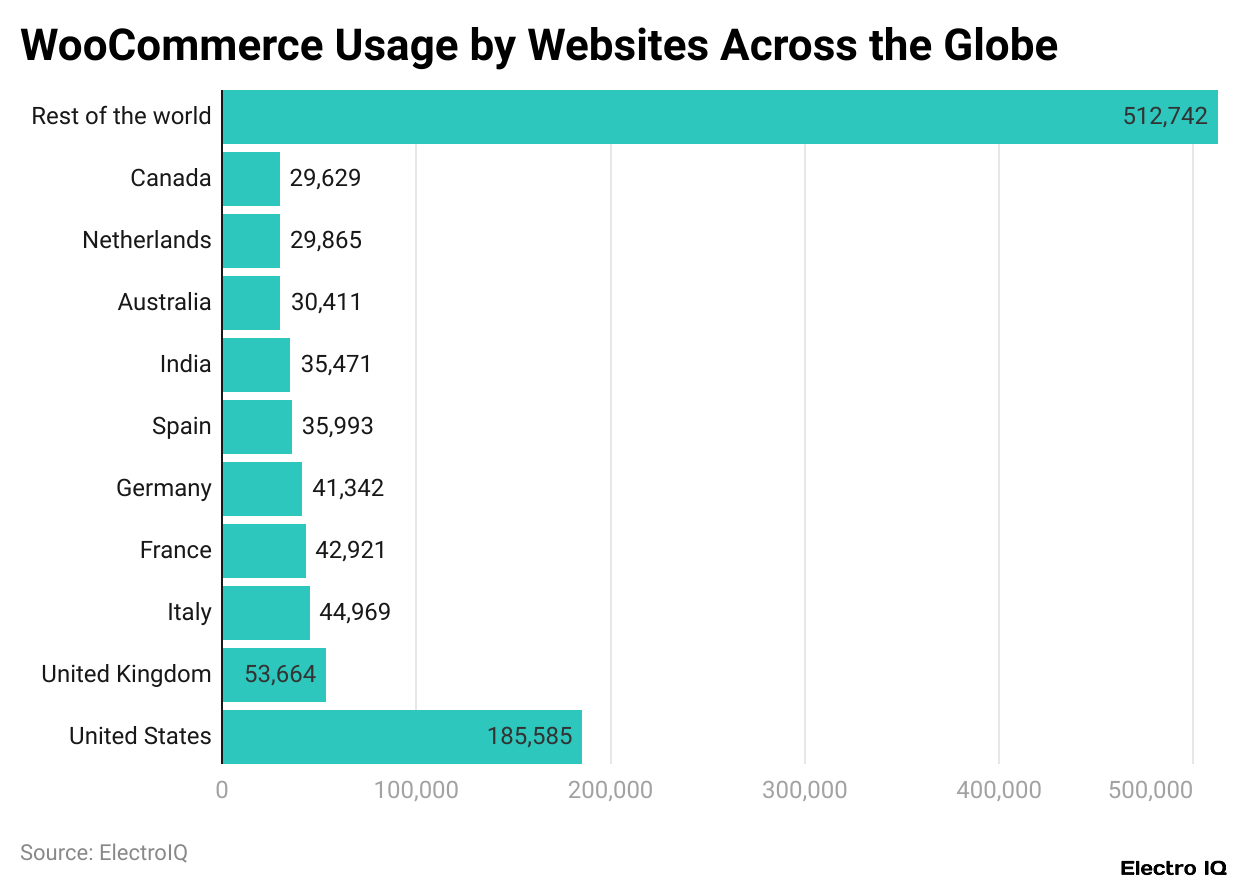
(Reference: colorwhistle.com)
- With 225,991, Shopify tops the list of companies hosting websites in the United States, whereas WooCommerce stands at 185,585 operating in the same region.
- Slightly ahead in the United Kingdom, WooCommerce boasts 53,664 sites, versus 43,659 for Shopify.
- Canada shows stronger web adoption for Shopify, being able to claim 44,969 sites as compared to WooCommerce, which stays at 29,629.
- Again, in Australia, Shopify is the lead player, with 42,921 sites as opposed to WooCommerce’s 30,411.
- Labelled with a paradox, WooCommerce gets more popularity in Italy, with 44,969 sites as against Shopify’s 29,865.
- In France, similarly, WooCommerce hosts 42,921 websites, a slightly higher count than Shopify, which stands at 35,471.
- With a narrow margin in favour of WooCommerce, there are 41,342 sites against the 35,993 hosted by Shopify. Japan prefers a stronger alliance with Shopify, with 30,411 websites, while WooCommerce does not make it to the top list in that country. India almost equals the contest, with Shopify marginally topping at 41,342 sites, while WooCommerce stands at 35,471.
- In Brazil, Shopify has 29,629 websites, but WooCommerce does not seem to hold a prominent position in the top rankings.
- On the contrary, WooCommerce enjoys higher popularity in Spain and the Netherlands, with 35,993 and 29,865 sites, respectively, and both countries do not feature prominently in Shopify.
- In the rest-of-world category, WooCommerce boasts much stronger leads with 512,742 websites, way outnumbering Shopify’s 189,481. This shows that WooCommerce is more widely adopted internationally across areas outside the top ten countries.
Cost Comparison Between Shopify And WooCommerce
- Shopify and WooCommerce face different cost structures due to their business setup: While Shopify is set up on a subscription basis with fixed monthly plans, WooCommerce is open-source and free to use but with costs that vary according to hosting, domains and premium add-ons.
- In 2024, Shopify will maintain three main pricing levels: the Basic Plan at US$39 per month, the Shopify Plan at US$105 per month, and the Advanced Plan, which charges US$399 per month.
- When apps and add-ons are thrown in, the average Shopify user ends up spending close to US$84 per month.
- These prices cover hosting, security, and support, so it is very predictable and manageable from a budgeting standpoint. Consider the buyer who simply wants one solution on which to concentrate.
- WooCommerce, however, has a more scalable cost structure, with hosting typically falling anywhere between US$10 and US$25 per month, while domain registration costs would be anywhere from US$10 to US$15 per year. SSL certificates are usually included free with hosting.
- Premium plugins or themes might set you back US$100 to US$300 per year, depending on the complexity and features the store needs.
- Generally, WooCommerce store owners end up spending somewhere between US$30 and US$60 per month, yet this can widely vary depending on the setup.
- Shopify just says easy and with predictable pricing, while WooCommerce tends to be cheaper but demands more management.
Shopify vs WooCommerce Security Statistics
- Shopify and WooCommerce both put a heavy emphasis on security, and they approach protection and confidence differently.
- Shopify, to state the obvious, is backed by a fully hosted and secure infrastructure that includes PCI DSS compliance, SSL certificates, certificate-based authentication for administrators, encrypted data storage with multiple keys, multi-factor authentication, and built-in fraud analysis tools.
- In comparison, WooCommerce stores rely heavily on their hosting providers and third-party tools to achieve a level of protection, with 90 %+ of WooCommerce sites having SSL certificates installed as of 2024.
- The infrastructural edifice constituted by Shopify’s global CDN, DDoS protection mechanism, and round-the-clock security monitoring makes the platform nearly infinitely scalable and supremely reliable during high-traffic events.
- On the other hand, WooCommerce has been increasingly embracing a similar line of approach in that some 60% of its stores implement web application firewalls, and bot protection services are utilised by some 55%. Both platforms take a proactive stance toward vulnerabilities.
- WooCommerce patched 64 security issues in 2024, while Shopify runs a Whitehat Bug Bounty program that incentivises ethical hackers to find faults in its system.
- Fraud detection on the system itself has been improved through machine learning integration and, more importantly, by teaming up with Chargeflow for automatic chargeback management processed straight from its admin dashboard.
- Chargebacks remain an issue across platforms: Shopify estimates merchants lose at least 0.47% of their revenue per year to chargebacks, the average being 0.52%.
- A chargeback fee by Shopify of US$15 is refunded to the merchant if the dispute is won, an advantage that many other platforms simply do not provide.
- Now, WooCommerce provides no chargeback tools of its own and depends on payment gateways like Stripe or PayPal, with which terms and protections vary.
- Malware scanning is yet another area of interest. About 65% of WooCommerce users will conduct a scan regularly, while Shopify takes care of security and threat detection on the backend.
- Shopify also states it has protected over US$13 billion in gross merchandise value and maintains a 99.9% order approval rate for one merchant using Shopify Payments, which is testimony to its fraud-prevention capabilities.
Conclusion
Shopify vs WooCommerce statistics: The good times of both Shopify and WooCommerce continue well into 2024, with millions of users and billions in transactions. Shopify, for its simplicity and hosting power, serves all-in-one convenience for businesses keen on launching quickly without having to deal with the technical overhead.
By contrast, WooCommerce offers unparalleled flexibility and customisation while being a less expensive option over time, for someone willing to manage their hosting and plugins. These two are good platforms to work on, but they shine in different ways.
FAQ.
With 38.74% of the share, WooCommerce holds a larger market share in 2024, much ahead of Shopify with its 10.32%. The integration with WordPress, a smooth and open technical platform, has essentially given it the edge.
By Q2 2025, it was estimated that WooCommerce supports roughly 4.64 million active stores. Shopify enjoys immense presence with 2.85 million stores based solely in the U.S. WooCommerce’s appeal across countries such as India and Italy adds to its bigger store count.
Shopify: Typical users pay US$84 monthly; plan costs range from US$39 to US$399, including hosting, security, and support. WooCommerce: Normally in the US$30-US$60 monthly range, depending on hosts, themes, and plugins. It is open-source, requiring no direct payment; costs can vary widely depending on setup and third-party services involved.
Shopify offers built-in security, including PCI DSS compliance, SSL, fraud detection, and 24/7 monitoring. It also has automated chargeback management and protected over US$13 billion in GMV. WooCommerce, while secure, depends on hosting providers and third-party tools. As of 2024, over 90% of WooCommerce sites use SSL, and 60% use firewalls, but malware scanning and chargeback management must be self-managed.
Shopify dominates in Lifestyle, Apparel, and Beauty, with the U.S., Canada, and Australia as top markets. WooCommerce is more widespread globally, leading in India, Italy, the Netherlands, and serving a broad range of niche industries, with 92.24% of its usage spread across “Others”

Barry Elad is a passionate technology and finance journalist who loves diving deep into various technology and finance topics. He gathers important statistics and facts to help others understand the tech and finance world better. With a keen interest in software, Barry writes about its benefits and how it can improve our daily lives. In his spare time, he enjoys experimenting with healthy recipes, practicing yoga, meditating, or taking nature walks with his child. Barry’s goal is to make complex tech and finance information easy and accessible for everyone.






